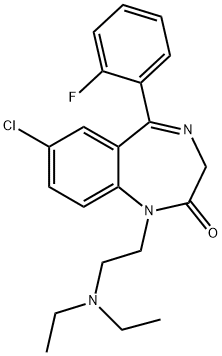Description
Flurazepam (CRM) (Item No. 18160) is a certified reference material that is structurally categorized as a benzodiazepine. It acts as a partial agonist of the benzodiazepine site on GABA
A receptors, potentiating the action of GABA with an EC
50 value of 930 nM in neuronal chick spinal cord cultures. Through this signaling mechanism, flurazepam produces anxiolytic and sedative properties that have been implemented clinically in the treatment of insomnia but also carry a potential for misuse. This product is intended for forensic and research purposes.
Chemical Properties
Flurazepam is a pale yellow crystalline
solid.
Originator
Dalmane, Roche,US,1970
Uses
Anticonvulsant; relaxant (muscle); sedative-hypnotic Dalmane (Valeant.
Definition
ChEBI: Flurazepam is a 1,4-benzodiazepinone that is 1,3-dihydro-2H-1,4-benzodiazepin-2-one substituted by a 2-(diethylamino)ethyl group, 2-fluorophenyl group and chloro group at positions 1, 5 and 7, respectively. It is a partial agonist of GABAA receptors and used for the treatment of insomnia. It has a role as a sedative, an anticonvulsant, a GABAA receptor agonist and an anxiolytic drug. It is a 1,4-benzodiazepinone, an organochlorine compound, a member of monofluorobenzenes and a tertiary amino compound.
Manufacturing Process
13 grams of 5-(2-fluorophenyl)-7-chloro-2,3-dihydro-1H-1,4benzodiazepinone-(2) were dissolved in 100 ml of N,N-dimethylformamide andtreated with 10.3 ml of a solution of sodium methoxide in methanol containing 54 mmol or 2.95 grams of sodium methoxide. The resulting solution was stirred at about 20°C for 1 hour and then cooled in an ice-salt mixture to 0°C. A solution of diethylamino-ethyl chloride was prepared by dissolving 13.8 grams of diethylamino-ethyl chloride hydrochloride in cold dilute sodium hydroxide solution and extracting the base four times with 50 ml of toluene each time. The toluene extracts were combined, dried over anhydrous sodium sulfate, filtered and added to the reaction mixture.
The mixture was allowed to stand for 70 hours and then concentrated to a small volume under reduced pressure. The residue was dissolved in 100 ml of methylene chloride, washed with 75 ml of water, three times with 50 ml of saturated brine solution each time and filtered over neutral alumina (grade 1). The filtrate was evaporated to dryness and the resulting colorless oil taken up in ether, which was then saturated with hydrogen chloride. The pale yellow precipitate was filtered off and recrystallized from methanol/ether yielding 1[2-(diethylamino)ethyl]-5-(2-fluorophenyl)-7-chloro-2,3-dihydro-1H-1,4benzodiazepinone-(2) dihydrochloride as pale yellow rods melting at 190° to 220°C with decomposition, (from British Patent 1,040,548).
Therapeutic Function
Hypnotic
Pharmacokinetics
Chlorazepate is yet another
benzodiazepine that is rapidly metabolized (3-decarboxylation) to N-desmethyldiazepam and so shares similar
clinical and pharmacokinetic properties to chlordiazepoxide and diazepam.
Side effects
The half-life of flurazepam is fairly long (~7 hours); consequently, it has the same
potential as chlordiazepoxide and diazepam to produce cumulative clinical effects and side effects (e.g., excessive
sedation) and residual pharmacological activity, even after discontinuation.
Safety Profile
Poison by intravenous
routes. Moderately toxic by ingestion and subcutaneous routes. Experimental
reproductive effects. Caution: May be habit forming. This is a controlled substance
(depressant) listed in the US. Code of
Federal Regulations, Title 21 Part 1308.14.
When heated to decomposition it emits very
toxic fumes of Cl-, Fand NOx. See also DIAZEPAM.
Potential Exposure
A Drug. Flurazepam is used as a seda tive in capsules or liquid form.
First aid
Eye Contact: Immediately remove any contactlenses and flush with large amounts of water for at least15 min, occasionally lifting upper and lower lids.Skin Contact: Remove contaminated clothing. Wash contaminated skin with water.
Metabolism
Flurazepam is administered orally as the dihydrochloride salt. It is rapidly 1N-dealkylated to give the 2′-fluoro
derivative of N-desmethyldiazepam, and it subsequently follows the same metabolic pathways as chlordiazepoxide
and diazepam.
storage
Color Code—Blue: Health Hazard/Poison: Storein a secure poison location. Store in tightly closed containers in a cool, well-ventilated area away from sources ofheat. If you are required to work in a “sterile” environmentyou require special training.
Shipping
UN3249 Medicine, solid, toxic, n.o.s., Hazard
Class: 6.1; Labels: 6.1-Poisonous materials.
Waste Disposal
It is inappropriate and possi bly dangerous to the environment to dispose of expired or
waste drugs and pharmaceuticals by flushing them down
the toilet or discarding them to the trash. Household quanti ties of expired or waste pharmaceuticals may be mixed
with wet cat litter or coffee grounds, double-bagged in
plastic, discard in trash. Larger quantities shall carefully
take into consideration applicable DEA, EPA, and FDA
regulations. If possible return the pharmaceutical to the
manufacturer for proper disposal being careful to properly
label and securely package the material. Alternatively, the
waste pharmaceutical shall be labeled, securely packaged
and transported by a state licensed medical waste contractor
to dispose by burial in a licensed hazardous or toxic waste
landfill or incinerator.



